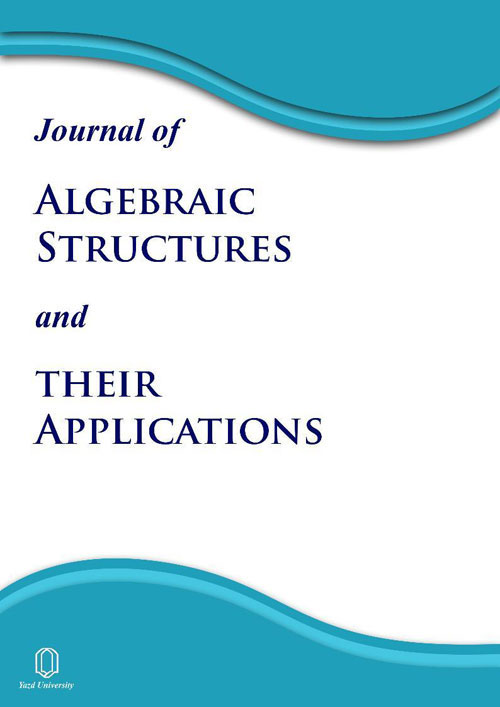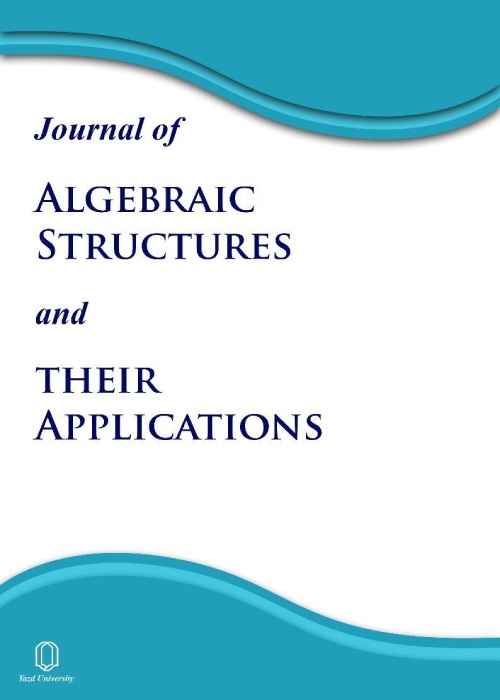فهرست مطالب

Journal of Algebraic Structures and Their Applications
Volume:7 Issue: 1, Winter and Spring 2020
- تاریخ انتشار: 1398/11/12
- تعداد عناوین: 12
-
-
Pages 1-10
The first part of the paper is concerned to relationship between the sets of associated primes of the generalized d-local cohomology modules and the ordinary gen eralized local cohomology modules. Assume that R is a commutative Noetherian local ring, M and N are finitely generated R-modules and d,t are two integers. We prove that AssHt d(M,N) = ∪I∈Φ AssHt I(M,N) whenever Hi d(M,N) = 0 for all i < t and Φ = {I : I is an ideal of R with dimR/I ≤ d}. In the second part of the paper, we give some information about the non-vanishing of the generalized d-local cohomology modules. To be more precise, we prove that Hi d(M,R) ̸= 0 if and only if i = n−d whenever R is a Gorenstein ring of dimension n and pdR(M) < ∞. This result leads to an example which shows that AssHn−d d (M,R) is not necessarily a finite set.
Keywords: Gorenstein Ring, Associted prime ideals, d-local cohomology modules -
Pages 11-20
We will study modules whose cofinite submodules have weak generalized-δ supplements. We attempt to investigate some properties of cofinitely weak generalized δ supplemented modules. We will prove for a module M and a semi-δ-hollow submodule N of M that, M is cofinitely weak generalized δ-supplemented if and only if M N is cofinitely weak generalized δ-supplemented. Also we show that any M-generated module is cofinitely weak generalized δ-supplemented module, where M is cofinitely weak generalized δ-supplemented. We obtain some other results about this kind of modules.
Keywords: Cofinite submodules, Cofinitely weak delta-supplemented modules, Cofinitely generalized delta-supplemented modules, Cofinitely weak generalized delta-supplemented modules, Semi-delta-hollow modules -
Pages 21-28
Let (R,m) be a Noetherian local ring, M a finitely generated R-module, and a an ideal of R. We define the a-minimum dimension d(a,M) of M by d(a,M) = Min{dim R p + a : p ∈ AsshR(M)}. In this paper, we show that cd(a,M) ≥ dimM−d(a,M) and we give some sufficient conditions and characterization for the equality to hold true.
Keywords: Local cohomology, cohomological dimension, cofinite modules -
Pages 29-40
Cofiniteness of the generalized local cohomology modules Hi a(M,N) of two Rmodules M and N with respect to an ideal a is studied for some i,s with a specified property. Furthermore, Artinianness of Hj b0(Hi a(M,N)) is investigated by using the above result, in certain graded situations, where b0 is an ideal of R0 and a = a0 + R+ such that b0 + a0 is an m0-primary ideal.
Keywords: Local cohomology, Finiteness, Serre subcategory -
Pages 41-47
In this paper, it is shown that (V,X) is a Schur pair if and only if the Baerinvariant of an X-group with respect toV is an X-group. Also, it is proved that a locally X class inherited the Schur pair property of , whenever X is closed with respect to forming subgroup, images and extensions of its members. Subsequently, many interesting predicates about some generalizations of Schur’s theorem and Schur multiplier of groups will be concluded.
Keywords: Variety of groups, Class of groups, Schur pair property, Baer-invariant of groups -
Pages 49-57
Let $M$ be a module over a ring $R$. We call $M$,$delta$-$H$-supplemented provided for every submodule $N$ of $M$ there is a direct summand $D$ of $M$ such that $M=N+X$ if and only if $M=D+X$ for every submodule $X$ of $M$ with $M/X$ singular. We prove that $M$ is $delta$-$H$-supplemented if and only if for every submodule $N$ of $M$ there exists a direct summand $D$ of $M$ such that $(N+D)/Nll_{delta} M/N$ and $(N+D)/Dll_{delta} M/D$.
*The formula is not displayed correctly!Keywords: delta-small submodule, H-supplemented module, delta-H-supplemented module -
Pages 59-67
In this paper, we use the primitive permutation representations of the simple groups $PSL_2(53)$, $PSL_2(61)$ and $PSL_2(64)$ and construct 1-designs by the Key-Moori Method 1.It is shown that the groups $PSL_2(53)$, $PSL_2(53)text{:}2$, $PSL_2(61)$, $PSL_2(61)text{:}2$, $PSL_2(64)$, $PSL_2(64)text{:}2$, $PSL_2(64)text{:}3$ and $PSL_2(64)text{:}6$ appear as the full automorphism groups of these obtained designs.
*The formula is not displayed correctly!Keywords: Design, Automorphism group, Projective special linear group -
Pages 69-82
Terms like commutativity degree, non-commuting graph and isoclinism are far well-known for much of the group theorists nowadays. There are so many papers about each of these concepts and also about their relationships in finite groups. Also, there are some recent researches about generalizing these notions in finite rings and their connexions.The concepts of commutativity degree and non-commuting graph are also extended to non-associative structures such as Moufang loops and some part of the known results in group theory in these contexts have been expanded to them.In this paper, we are going to generalize the notion of isoclinism in finite Moufang loops and then study the relationships between these three concepts. Among other results, we prove that two isoclinic finite Moufang loops have the same commutativity degree and if they have the same sizes of centers and commutants then they have isomorphic non-commuting graphs. Also, the converses of these results have been investigated.Furthermore, it has been proved that a finite simple group can be characterized by its non-commuting graph. We will prove the same is true for a finite simple Moufang loop by imposing one additional hypothesis, namely, the isoclinism of the regarding loops.
Keywords: Loop theory_Finite Moufang loops_Isoclinism_Non-commuting graph of a finite group_Commutativty degree -
Pages 83-99
In this paper, we define the notion of strongly annihilating-submodule graph of modules. This graph is a straightforward common generalization of the annihilating-submodule graph and the annihilating-ideal graph. In addition to providing the properties of this graph in general, we investigate the behavior of the graph when modules are reduced or divisible.
Keywords: Annihilating-submodule graph, Strongly annihilating-submodule graph, reduced module, divisible module -
Pages 101-115
In this paper, we give some generalized categories of topological spaces in terms of monotone operators and investigate some categorical properties of them. In particular, we present some equivalent categories of generalized topological spaces in terms of closure and interior operators. Also, we study the properties of some classes of morphisms as final, initial, closed and open morphisms in these categories.
Keywords: Generalized topology, generalized category, monotone operator, closure, interior operator -
Pages 117-125
In this paper, we define convex, balanced and absorbing subsets of a hypervector space $V$ over a field $K$, where $K$ is considered $mathbb{R}$ or $mathbb{C}$ and give some examples of them. We prove that every subspace of a hypervector space is a convex and balanced subset. Also, for every regular equivalence relation $rho$ on a hypervector space $V$, we show that if $A$ is a convex, balanced or an absorbing subset of $V$, then $A/rho$ is respectively a convex, balanced or an absorbing subset of a hypervector space $V/rho$.
*The formula is not displayed correctly!
Keywords: Hypervector space, Convex set, Balanced set, Absorbing set -
Pages 127-141
In this paper, the notion of a medial filter in a BE-algebra is defined, and the theory of filters in BE-algebras is developed. These filters are very important for the study of congruence relations in BE-algebras. Moreover, the relationships between implicative filters, medial filters and normal filters are investigated.
Keywords: BE, CI-algebra, (implicative, medial, normal) filter


